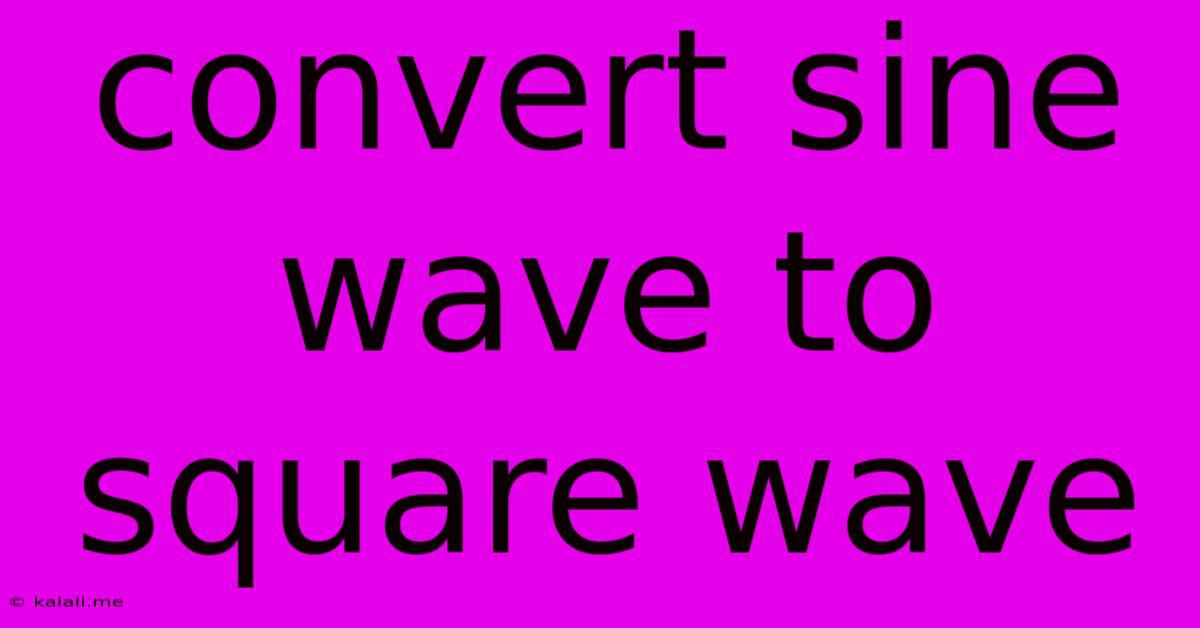Convert Sine Wave To Square Wave
Kalali
Jun 04, 2025 · 4 min read

Table of Contents
Converting a Sine Wave to a Square Wave: Techniques and Applications
Meta Description: Learn how to transform a smooth sine wave into a sharp square wave using various methods, including comparators, Schmitt triggers, and digital logic. Discover the applications of this crucial signal processing technique.
Converting a sine wave to a square wave is a fundamental task in electronics and signal processing. A sine wave, characterized by its smooth, continuous oscillation, often needs to be transformed into a square wave, a signal with abrupt transitions between high and low states. This conversion is crucial in various applications, from digital logic circuits to frequency multipliers and timing circuits. This article will explore different methods for achieving this conversion, discussing their advantages and limitations.
Understanding the Difference: Sine Wave vs. Square Wave
Before diving into conversion methods, let's briefly recap the differences. A sine wave is a continuous, sinusoidal waveform defined by its amplitude and frequency. Its smooth transitions make it ideal for representing analog signals. A square wave, on the other hand, is a non-sinusoidal waveform characterized by rapid transitions between two distinct voltage levels (high and low). Its sharp edges and distinct levels make it ideal for digital systems.
Methods for Sine Wave to Square Wave Conversion
Several methods effectively achieve this conversion, each with its own strengths and weaknesses:
1. Comparator: A comparator is an analog circuit that compares two input voltages. If the sine wave input exceeds a reference voltage (typically set at zero or half the sine wave's amplitude), the output switches to a high state; otherwise, it switches to a low state. This simple setup efficiently converts the sine wave into a crude square wave. However, the resulting square wave might have inconsistent pulse widths, particularly around the zero-crossing points, due to noise or variations in the input signal.
2. Schmitt Trigger: A Schmitt trigger is a comparator with hysteresis. Hysteresis means the trigger level for switching from high to low is different from the trigger level for switching from low to high. This characteristic prevents unwanted oscillations or "chattering" near the threshold voltage, resulting in a cleaner and more stable square wave than a simple comparator. This makes it a preferred method for noisy environments.
3. Precision Rectifier and Threshold Detector: A precision rectifier can be used to obtain the absolute value of the sine wave. This absolute value signal is then compared against a threshold voltage using a comparator. This method offers improved accuracy and consistency compared to simple comparators, especially in applications requiring precise timing or pulse width.
4. Digital Logic Gates: For digitally processed sine waves (i.e., after analog-to-digital conversion), simple logic gates like a comparator or even a simple thresholding function can be utilized within a microcontroller or digital signal processor (DSP) to generate a square wave. This approach leverages the inherent precision and speed of digital processing.
Choosing the Right Method
The optimal method depends on the specific application and requirements.
- For simple applications and tolerance for some imperfection: A basic comparator might suffice.
- For noise-sensitive applications requiring a clean square wave: A Schmitt trigger is the preferred choice.
- For applications demanding precision and accuracy: A precision rectifier with threshold detection provides superior performance.
- For digitally-processed signals: Using digital logic gates within a microcontroller or DSP is the most efficient and accurate method.
Applications of Sine Wave to Square Wave Conversion
This conversion technique has widespread applications:
- Digital Signal Processing: Converting analog signals to digital representations.
- Timing Circuits: Generating precise timing pulses for control systems.
- Frequency Multipliers: Increasing the frequency of a signal.
- PWM Generation: Creating Pulse Width Modulation signals for power control.
- Clock Generation: Generating clock signals for digital circuits.
Conclusion
Converting a sine wave to a square wave is a common signal processing task with diverse applications. By understanding the various methods and their characteristics, engineers and hobbyists can select the most suitable approach to meet the specific requirements of their projects. The choice between a simple comparator, Schmitt trigger, precision rectifier or digital logic depends heavily on factors like noise tolerance, precision needs, and the overall design of the system. Remember to consider factors like input signal characteristics and required output quality when making your selection.
Latest Posts
Latest Posts
-
There Is A Beast Beneath The Boards
Jun 06, 2025
-
Building A Level Concrete Slab On A Slope
Jun 06, 2025
-
What Can I Use As A Mousepad
Jun 06, 2025
-
Cat Poops In Litter Box But Pees On Floor
Jun 06, 2025
-
Max Wattage To Charge Macbook Pro
Jun 06, 2025
Related Post
Thank you for visiting our website which covers about Convert Sine Wave To Square Wave . We hope the information provided has been useful to you. Feel free to contact us if you have any questions or need further assistance. See you next time and don't miss to bookmark.